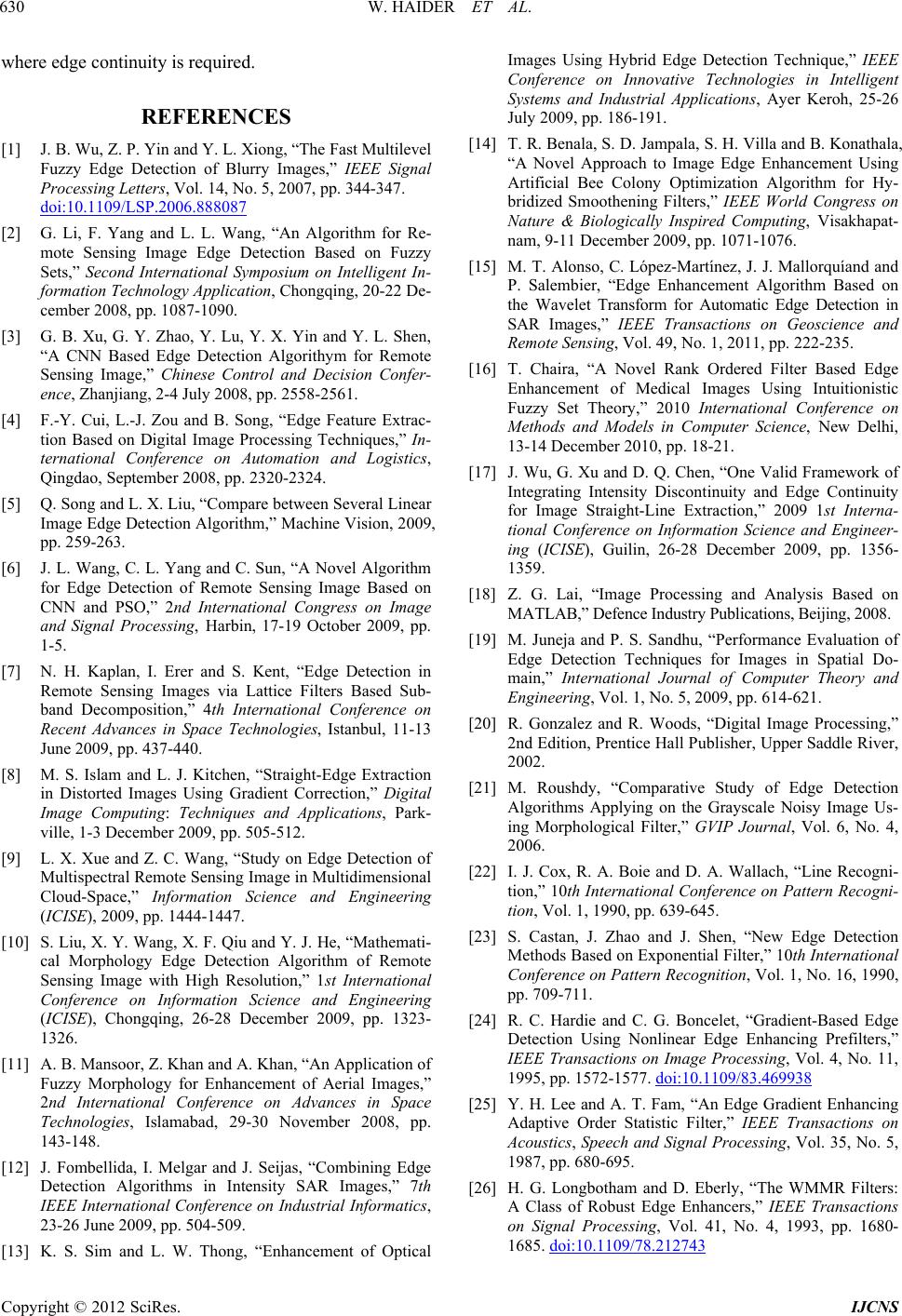
W. HAIDER ET AL.
630
where edge continuity is required.
REFERENCES
[1] J. B. Wu, Z. P. Yin and Y. L. Xiong, “The Fast Multilevel
Fuzzy Edge Detection of Blurry Images,” IEEE Signal
Processing Letters, Vol. 14, No. 5, 2007, pp. 344-347.
doi:10.1109/LSP.2006.888087
[2] G. Li, F. Yang and L. L. Wang, “An Algorithm for Re-
mote Sensing Image Edge Detection Based on Fuzzy
Sets,” Second International Symposium on Intelligent In-
formation Technology Application, Chongqing, 20-22 De-
cember 2008, pp. 1087-1090.
[3] G. B. Xu, G. Y. Zhao, Y. Lu, Y. X. Yin and Y. L. Shen,
“A CNN Based Edge Detection Algorithym for Remote
Sensing Image,” Chinese Control and Decision Confer-
ence, Zhanjiang, 2-4 July 2008, pp. 2558-2561.
[4] F.-Y. Cui, L.-J. Zou and B. Song, “Edge Feature Extrac-
tion Based on Digital Image Processing Techniques,” In-
ternational Conference on Automation and Logistics,
Qingdao, September 2008, pp. 2320-2324.
[5] Q. Song and L. X. Liu, “Compare between Several Linear
Image Edge Detection Algorithm,” Machine Vision, 2009,
pp. 259-263.
[6] J. L. Wang, C. L. Yang and C. Sun, “A Novel Algorithm
for Edge Detection of Remote Sensing Image Based on
CNN and PSO,” 2nd International Congress on Image
and Signal Processing, Harbin, 17-19 October 2009, pp.
1-5.
[7] N. H. Kaplan, I. Erer and S. Kent, “Edge Detection in
Remote Sensing Images via Lattice Filters Based Sub-
band Decomposition,” 4th International Conference on
Recent Advances in Space Technologies, Istanbul, 11-13
June 2009, pp. 437-440.
[8] M. S. Islam and L. J. Kitchen, “Straight-Edge Extraction
in Distorted Images Using Gradient Correction,” Digital
Image Computing: Techniques and Applications, Park-
ville, 1-3 December 2009, pp. 505-512.
[9] L. X. Xue and Z. C. Wang, “Study on Edge Detection of
Multispectral Remote Sensing Image in Multidimensional
Cloud-Space,” Information Science and Engineering
(ICISE), 2009, pp. 1444-1447.
[10] S. Liu, X. Y. Wang, X. F. Qiu and Y. J. He, “Mathemati -
cal Morphology Edge Detection Algorithm of Remote
Sensing Image with High Resolution,” 1st International
Conference on Information Science and Engineering
(ICISE), Chongqing, 26-28 December 2009, pp. 1323-
1326.
[11] A. B. Mansoor, Z. Khan and A. Khan, “An Application of
Fuzzy Morphology for Enhancement of Aerial Images,”
2nd International Conference on Advances in Space
Technologies, Islamabad, 29-30 November 2008, pp.
143-148.
[12] J. Fombellida, I. Melgar and J. Seijas, “Combining Edge
Detection Algorithms in Intensity SAR Images,” 7th
IEEE International Conference on Industrial Informatics,
23-26 June 2009, pp. 504-509.
[13] K. S. Sim and L. W. Thong, “Enhancement of Optical
Images Using Hybrid Edge Detection Technique,” IEEE
Conference on Innovative Technologies in Intelligent
Systems and Industrial Applications, Ayer Keroh, 25-26
July 2009, pp. 186-191.
[14] T. R. Benala, S. D. Jampala, S. H. Villa and B. Konathala,
“A Novel Approach to Image Edge Enhancement Using
Artificial Bee Colony Optimization Algorithm for Hy-
bridized Smoothening Filters,” IEEE World Congress on
Nature & Biologically Inspired Computing, Visakhapat-
nam, 9-11 December 2009, pp. 1071-1076.
[15] M. T. Alonso, C. López-Martínez, J. J. Mallorquíand and
P. Salembier, “Edge Enhancement Algorithm Based on
the Wavelet Transform for Automatic Edge Detection in
SAR Images,” IEEE Transactions on Geoscience and
Remote Sensing, Vol. 49, No. 1, 2011, pp. 222-235.
[16] T. Chaira, “A Novel Rank Ordered Filter Based Edge
Enhancement of Medical Images Using Intuitionistic
Fuzzy Set Theory,” 2010 International Conference on
Methods and Models in Computer Science, New Delhi,
13-14 December 2010, pp. 18-21.
[17] J. Wu, G. Xu and D. Q. Chen, “One Valid Framework of
Integrating Intensity Discontinuity and Edge Continuity
for Image Straight-Line Extraction,” 2009 1st Interna-
tional Conference on Information Science and Engineer-
ing (ICISE), Guilin, 26-28 December 2009, pp. 1356-
1359.
[18] Z. G. Lai, “Image Processing and Analysis Based on
MATLAB,” Defence Industry Publications, Beijing, 2008.
[19] M. Juneja and P. S. Sandhu, “Performance Evaluation of
Edge Detection Techniques for Images in Spatial Do-
main,” International Journal of Computer Theory and
Engineering, Vol. 1, No. 5, 2009, pp. 614-621.
[20] R. Gonzalez and R. Woods, “Digital Image Processing,”
2nd Edition, Prentice Hall Publisher, Upper Saddle River,
2002.
[21] M. Roushdy, “Comparative Study of Edge Detection
Algorithms Applying on the Grayscale Noisy Image Us-
ing Morphological Filter,” GVIP Journal, Vol. 6, No. 4,
2006.
[22] I. J. Cox, R. A. Boie and D. A. Wallach, “Line Recogni-
tion,” 10th International Conference on Pattern Recogni-
tion, Vol. 1, 1990, pp. 639-645.
[23] S. Castan, J. Zhao and J. Shen, “New Edge Detection
Methods Based on Exponential Filter,” 10th International
Conference on Pattern Recognition, Vol. 1, No. 16, 1990,
pp. 709-711.
[24] R. C. Hardie and C. G. Boncelet, “Gradient-Based Edge
Detection Using Nonlinear Edge Enhancing Prefilters,”
IEEE Transactions on Image Processing, Vol. 4, No. 11,
1995, pp. 1572-1577. doi:10.1109/83.469938
[25] Y. H. Lee and A. T. Fam, “An Edge Gradient Enhancing
Adaptive Order Statistic Filter,” IEEE Transactions on
Acoustics, Speech and Signal Processing, Vol. 35, No. 5,
1987, pp. 680-695.
[26] H. G. Longbotham and D. Eberly, “The WMMR Filters:
A Class of Robust Edge Enhancers,” IEEE Transactions
on Signal Processing, Vol. 41, No. 4, 1993, pp. 1680-
1685. doi:10.1109/78.212743
Copyright © 2012 SciRes. IJCNS